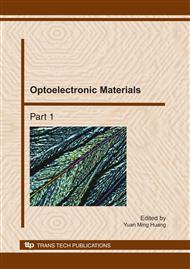p.733
p.737
p.743
p.751
p.755
p.759
p.763
p.767
p.771
The Anti-Glare Detector Based on Liquid Crystal
Abstract:
Based on the electro-optical property of liquid crystal (LC), an eye controlling anti-glare detector is designed in this paper. According to the transmission characteristics of SONY- LCX029 materials, the principle and working mode of anti-glare are described. The detector can get the object’s images by eye-controlling focus (ECF) module and exposure metering module. The LC can change each pixel’s transmission with the reasonably designed control circuit so that the glare is restrained. An experiment of SONY-LCX029 LCD (liquid crystal display) transmission changes with the gray level proved that the transmission of the LCD changes from 1.28% to 25.60%, reducing 2 orders of magnitude of strong light at least.
Info:
Periodical:
Pages:
755-758
Citation:
Online since:
November 2010
Authors:
Keywords:
Price:
Сopyright:
© 2011 Trans Tech Publications Ltd. All Rights Reserved
Share:
Citation:


